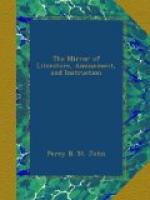THE MIRROR OF LITERATURE, AMUSEMENT, AND INSTRUCTION.
Vol. XIII, No. 365.] Saturday, April 11, 1829. [Price. 2d.
* * * * *
Old Somerset house.
[Illustration: Old Somerset house.]
The Engraving on the annexed page is, perhaps, one of the greatest antiquarian treasures it has for some time been our good fortune to introduce to the readers of the mirror. It represents the original Somerset house, which derived its name from Edward Seymour, Duke of Somerset, maternal uncle to Edward VI., and Protector of the realm during most of the reign of that youthful sovereign. The time at which this nobleman commenced his magnificent palace (called Somerset House) has been generally faxed at the year 1549; but that he had a residence on this spot still earlier, is evident from two of his own letters, as well as from his “cofferer’s” account, which states that from April 1, 1548, to October 7, 1551, “the entire cost of Somerset House, up to that period, amounted to 10,091l. 9s. 2d.” By comparing this sum with the value of money in the present day, we may form some idea of the splendour of the Protector’s palace, as well as from Stow, who, in his “Survaie,” second edition, published in 1603, styles it “a large and beautiful house, but yet unfinished.” The architect is supposed to have been John of Padua, who came to England in the reign of Henry VIII.—this being one of the first buildings designed from the Italian orders that was ever erected in this kingdom. Stow tells us there were several buildings pulled down to make room for this splendid structure, among which he enumerates the original parish church of St. Mary-le-Strand; Chester’s or Strand Inne; a house belonging to the Bishop of Llandaff; “in the high street a fayre bridge, called Strand Bridge, and under it a lane or waye, down to the landing-place on the banke of Thames;” and the Inne or London lodging of the Bishop of Chester and the Bishop of Worcester. Seymour states, that the site of St. Mary’s church became a part of the garden of Somerset House; and that when the Protector pulled down the old church, he promised to build a new one for the parishioners, but his death prevented his fulfilling that engagement. The Strand Bridge formed part of the public highway; and through it, according to Maitland, “ran a small watercourse from the fields, which, gliding along a lane below, had its influx to the Thames near Somerset Stairs."[1]
[1] The present Strand Lane
(as it would seem to have been called in
Strype’s
time) skirts the eastern side of Somerset House, and
forms
a boundary
between the parishes of St. Mary and St. Clement Danes.
At its stairs,
which are still, as formerly, “a place of some
note
to take
water at,” is the outlet of a small underground
stream.




